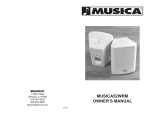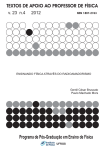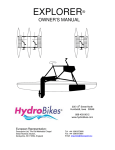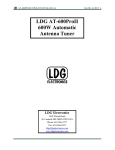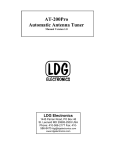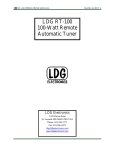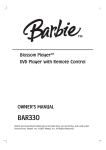Download S9 Antennas S9v Installation guide
Transcript
Model S9v 18’ Mk II Multiband Vertical Antenna Installation Guide S9v 18’ M k II Installation Guide _____________________________________________________________________________ WARNING: INSTALLATION OF THIS PRODUCT NEAR POWERLINES IS DANGEROUS. FOR YOUR SAFETY, FOLLOW THE INSTALLATION DIRECTIONS. INTRODUCTION Thank you for purchasing the S9v 18’ Mk II multiband vertical antenna, hereinafter referred to as the S9v. We believe the S9v to be the lightest, most efficient and safest full-size vertical antenna available and we sincerely hope that you enjoy your new S9v. The S9v is a tapered, ultra-lightweight 18’ fiberglass vertical antenna designed for fixed and portable Amateur Radio use from 20 through 6 meters. Friction locking sections and high-tech polymer tube rings allow the antenna to be quickly and safely deployed in practically any environment without tools. Please read this guide in its entirety FIRST before installing your S9v. The S9v is extremely easy to install and deploy, but reading through this guide first will make it a painless and enjoyable experience. BEFORE YOU GET STARTED… The S9v is shipped pre-assembled with all the components and hardware you need to install the antenna. You will need to furnish coax cable, an antenna tuner, a balun/unun, a small pipe or mast for the ground or roof mount, some radials, and weatherproofing material. Coax Cable For top performance, the S9v must be fed with a quality, low-loss 50-ohm coaxial feed line such as RG-213 or LMR400. ________________________________________________________________________ 2 S9v 18’ M k II Installation Guide _____________________________________________________________________________ Antenna Tuner Since the S9v is extremely close to ¼-wavelength on 20 meters, it can be used as a serious 20 meter monoband DX antenna using the antenna tuner inside your rig (or with an external antenna tuner). In this configuration, the coax cable can be directly connected to the S9v using the supplied ring terminal connectors. Radials and a 1:1 current choke balun (located outside of the radial field) are strongly recommended in this configuration. As a 20 meter monoband antenna, the S9v can be mounted on the ground or as an elevated ground plane antenna on a pole, on your roof or on a tower. If you want to use the S9v as a multi-band antenna, you will need a 4:1 unun and a quality antenna tuner in your shack. (Internal rig tuners do not have adequate range to match the higher impedances presented by the antenna on bands above 20 meters.) We recommend the LDG Electronics series of auto tuners for use with the S9v. LDG tuners easily handle the wide-range of impedances presented by the S9v over the higher HF frequencies. Using a weatherproofed, remote antenna tuner at the antenna feed point ensures absolute lowest signal loss and best overall multi-band performance. There are several remote antenna tuners on the market. When a remote tuner is used at the S9v feedpoint, a 4:1 unun is not required but a 1:1 current choke balun may be needed between your transmitter and the antenna (outside of the radial field) if you experience RF current in your shack. (Burying your coax cable also helps minimize RF current from flowing back into your shack.) Balun/Unun For 20 meter monoband use, a 1:1 choke balun should be inserted in-line with your coax outside of the radial field to prevent RF from coming back into your shack over the coax shield. There are several commercially-available 1:1 current choke baluns (Balun Designs being one of the best – see them at www.balundesigns.com) or you can create a simple current choke balun using your coax feed line. ________________________________________________________________________ 3 S9v 18’ M k II Installation Guide _____________________________________________________________________________ To create a 1:1 current choke balun using your coax feed line, simply wind 18 feet of your coax feed line (outside the radial field) evenly around a 4-inch round form such as a PVC pipe. You can use zip lock cable ties to secure the windings and to maintain the coil form. Additional information about constructing an inexpensive 1:1 choke balun using your coax feedline can be found on-line at: http://www.hamuniverse.com/balun.html. For multi-band use, a 4:1 “unun” from Balun Designs is recommended at the antenna feed point. A 4:1 unun helps lower the higher impedances presented by the S9v on frequencies above 20 meters. Balun Designs sells two 4:1 ununs specifically for the S9v, depending on the amount of power you expect to run. These ununs may be purchased on-line at www.balundesigns.com: • If you are running 300 watts or less, use the Balun Designs “Model 4130sv for S9 Vertical”. • If you running more than 300 watts, use the Balun Designs “4:1 Unun for Verticals” (Model # 4134). Up to 300W: Balun Designs 4:1 Unun for S9 Vertical (Model 4130sv) Above 300W: Balun Designs 4:1 Unun for Verticals (Model 4134) In a multi-band configuration, expect excellent results on 20 through 10 meters. The antenna may be used on 6 meters provided your antenna tuner covers 6 meters. ________________________________________________________________________ 4 S9v 18’ M k II Installation Guide _____________________________________________________________________________ Ground or Elevated Mount A 1” OD or smaller diameter pipe is required for the S9v to be mounted on the ground or in the air. For permanent ground-mount installations, we suggest using a 2 foot length of ¾-inch galvanized plumbing pipe from a hardware store like Home DepotTM or LowesTM, as shown below. This 2-foot long, 3/4” pipe has an OD of 1 inch and sells for around $5 - it makes a perfect ground mount for the S9v. The S9v base tube simply slips over the pipe for an easy and elegant deployment. (A mechanical connection from the antenna base tube to the pipe is neither required nor desired.) NOTE: Do NOT use a pipe with an OD larger than 1” or it will be impossible to slip the S9v base tube over the pipe. For elevated installations, the S9v functions as a ground plane (GP) antenna and four, ¼-wave radials are required per band as discussed below. Because the S9v is so light, you can roof-mount the antenna using a simple TV-type tripod from Radio ShackTM or any electronics store or mount it on a push-up pole. We suggest using a 3 to 4 foot fiberglass mast with a roof tripod. Again, do not use a mast with an OD larger than 1”. Home DepotTM and LowesTM sell brooms and tools with fiberglass handles and these handles make great masts. ________________________________________________________________________ 5 S9v 18’ M k II Installation Guide _____________________________________________________________________________ To create a mount for the S9v, simply install a U-bolt (not supplied) around the fiberglass mast about 12” from the top of the mast. The S9v will slip over the mast and rest on the u-bolt. You can then attach the four ¼-wave radials to the u-bolt using ring terminal connectors. Then, attach your coax shield/unun ground connection to the u-bolt. Do NOT run a wire from the u-bolt/coax shield/elevated radials to an earth ground. Radials For optimum performance, the S9v should be used against a good RF ground. A ground rod is not an effective RF ground! For an effective RF ground, use radial wires constructed from 14 – 16 AWG stranded insulated copper wire. For ground-mounted installations, use at least 16 radials (32 preferred), with each radial at least 0.2 wavelength at the lowest operating frequency (14 MHz) which is 13.37 feet (13 feet, 5 inches long). There is no precise formula to calculate the length of ground-mounted radials because everyone has different soil and soil tends to change the electrical length of the radials. However, a general rule of thumb for radials is: “longer” and “more” is better. If you have the time and resources, 32 or more radials at least 13 feet, 5 inches in length (or longer) should be considered. It is highly recommend that you use a radial plate to connect and organize your radials. The optional S9 Radial Plate has 36 radial mounting holes and includes 20 sets of stainless steel hardware – enough to connect 40 radials to the plate. Additional, detailed information on ground-mounted radials can be found on page 21. S9 Radial Plate ________________________________________________________________________ 6 S9v 18’ M k II Installation Guide _____________________________________________________________________________ For elevated installations, use 4 radials per band, each ¼ wavelength long. Attach the radials (and your coax shield) to the mast u-bolt at the base of the antenna using ring terminal connectors. If possible position the radials equally around the S9v base. You may drop the radials away from the S9v at a 45degree angle to the base, if desired, or lay them flat on a roof. Attach insulators to the ends of each radial. Do NOT run a ground wire from the radials/coax shield to an earth ground. S9v COMPONENTS The S9v consists of six lightweight telescoping tapered fiberglass tubes with a continuous, insulated vertical element wire inside the tubes. The base tube functions as a hard shell case, protecting the collapsed fiberglass sections. The antenna is shipped with end caps and polymer tube rings to retain the telescoping sections and to facilitate portable operation. The hardware that is provided with the antenna is shown on the next page. ________________________________________________________________________ 7 S9v 18’ M k II Installation Guide _____________________________________________________________________________ S9v 18’ MK II – HARDWARE Hook Tool Used to Retrieve Element Wire from Antenna Spare Vinyl Cap for Antenna Tip Four Polymer Tube Rings Two Ring Terminal Connectors and Hardware for Coax Center and Shield Lower End of S9v 18’ Vertical Element Wire ________________________________________________________________________ 8 S9v 18’ M k II Installation Guide _____________________________________________________________________________ ABOUT THE TUBE RINGS… - The polymer tube rings are not clamps – they are “stops” that are used to keep the associated tube section from collapsing down into the tube immediately below it. - Slide a tube ring over the tube and use your thumb and index finger to loosely latch the ring about 15 to 20 inches above the adjoining, lower tube. ________________________________________________________________________ 9 S9v 18’ M k II Installation Guide _____________________________________________________________________________ ABOUT THE TUBE RINGS (Con’t) - Next, slide the ring down the tube to see if it fits tightly against the top edge of the adjoining lower tube. - If the ring is not tight, slide the ring back up the tube, use your thumb and index finger to advance the latch ONE MORE CLICK. Repeat the previous step and this step until the ring fits tightly against the top edge of the lower tube section as shown above. - Once a tube ring is properly latched, there is no need to unlatch or change the ring latch setting – simply slide the rings on and off the tubes each time you assemble or disassemble the antenna. ________________________________________________________________________ 10 S9v 18’ M k II Installation Guide _____________________________________________________________________________ HOW TO UNLATCH A TUBE RING Unlatching a tube ring is easy! Use both hands. Push forward on one tab while pulling back on the other tab to free the latching mechanism, as shown below. ________________________________________________________________________ 11 S9v 18’ M k II Installation Guide _____________________________________________________________________________ INSTALLING THE S9v 1. Select the Site. Try to use as open an area as possible to deploy the S9v. Even though the S9v is completely insulated, you absolutely MUST locate the antenna site at least 27’ away from power lines (1.5x the length of the antenna). In fact, an ideal installation site would be a least 27’ away from any other large object such as a house or trees. 2. Install the Mount. The S9v requires a mount. The elevated mount was discussed earlier. For ground-mount installations, you will need a large hammer, a spare piece of wood and a level to install the pipe in the ground. IMPORTANT! Place a piece of wood over the top of the pipe to protect the top edges from becoming deformed. Hammer the piece of wood in a straight downward direction. Do NOT directly hammer the pipe – hammer the wood to protect the pipe. ________________________________________________________________________ 12 S9v 18’ M k II Installation Guide _____________________________________________________________________________ Drive the 1” max OD pipe into ground leaving a maximum of 12 inches above the ground NOTE: Use a level while you are installing the pipe to ensure that it is as straight as possible in the vertical plane. Drive the 1 inch max OD pipe into the ground leaving 12 INCHES MAXIMUM above the ground. 3. Install the Radial Plate. After you have installed the pipe, install the S9 Radial Plate. (The S9 Radial Plate simply slips over the pipe.) 4. Assemble the S9v. To assemble the S9v antenna: a. Lay the S9v on the ground and unwind the vertical element wire away from the base tube in a straight line. Don’t pull unnecessarily on the wire – the idea is to just un-roll the wire to its full length. Once the wire is completely unrolled, pull small sections of the wire through your hands to straighten the wire a little. NOTE: The wire does NOT have to be perfectly straight, so don’t spend a lot of time trying to straighten the wire! ________________________________________________________________________ 13 S9v 18’ M k II Installation Guide _____________________________________________________________________________ Unwind wire straight out from base tube until it is fully extended along the ground b. Next, remove the TOP cap plug (pulls off). Do NOT unscrew the BOTTOM end cap where the wire exits. Put the top cap plug in your pocket so that it will not be lost in the grass. c. We are ready to extend the antenna sections. The S9v should still be laying flat on the ground. To extend the antenna, grab a section of the wire near the bottom end cap and push the wire into the base tube. This action should cause the top, thinnest section of the antenna (it has a cap on its tip) to pop out of the top of the base tube. (If this doesn’t work, pickup the base tube and shake it slightly while pointing the top part of the tube downward.) Grab top section here (not the cap) and pull straight out to retrieve the next section. Repeat until all sections are extended from the base tube. ________________________________________________________________________ 14 S9v 18’ M k II Installation Guide _____________________________________________________________________________ d. Gently pull the top, thinnest section straight out of the base tube (pull the section, not the cap) until it catches and pulls the next, lower section out. Gently twist the top section to lock it into the lower section. Now, pull the lower section straight out until the next section appears. Repeat this you have extended all the sections EXCEPT FOR THE SECTION ABOVE THE BOTTOM BASE TUBE. Pull and twist the upper sections to frictionlock them but don’t overdo it as it may be difficult to collapse the sections later on. e. As shown below, each upper tube section (except the top, tip section) requires a polymer tube ring to prevent the tube from collapsing down into the larger diameter tube immediately below it. f. To install a ring, slide it over the top of each upper section and use your thumb and index finger to squeeze the ring tabs until the teeth click together, as shown below. ________________________________________________________________________ 15 S9v 18’ M k II Installation Guide _____________________________________________________________________________ g. Next, slide the ring down the tube toward the lower, larger tube section. All tube diameters are tapered, so the goal is to have the ring fit tightly against the top of the adjoining lower tube section. You may have to slide the ring back up the tube (where the diameter is smaller) to advance the ring latch another click and then slide the ring back down the tube before you find the perfect fit. No pliers or tools are needed! This process is easily done by hand. Use common sense to determine when a ring is tight enough to keep the associated tube from collapsing. NOTE: Unlatching a tube ring is easy! Use both hands. Push forward on one ring tab while pulling back on the other tab to free the latching mechanism. h. The top tip section does not require a tube ring. To secure the top section, hold the section below it with one hand and firmly twist and pull the tip section with your other hand until it is firmly friction-locked in place. NOTE: The antenna should now be fully extended except for the section above the base tube. i. The end of the vertical element wire is terminated with a male bullet connector and a rubber band to make retrieving the wire fast and easy. ________________________________________________________________________ 16 S9v 18’ M k II Installation Guide _____________________________________________________________________________ j. Note how the rubber band is looped around itself on the tip of the connector. Now, remove the rubber band from the connector and unscrew the black plastic cap from the bottom of the S9v base tube. Next, poke the bare connector through the hole near the center of the black plastic cap and remove the cap. Hang on to the cap as we will screw it back on in a few steps. k. Now, re-attach the rubber band. Be sure to loop it tightly around the metal tip of the connector as shown below. l. Fully extend the section above the base tube. The bullet connector and rubber band will disappear into the base tube as the upper section is fully expanded. m. Now, install the largest tube ring on the section above the base tube like we did with the thinner, upper sections. ________________________________________________________________________ 17 S9v 18’ M k II Installation Guide _____________________________________________________________________________ n. To retrieve the vertical element wire from the antenna, use the hook tool to fish the rubber band loop out of the exit hole in the side of the base tube (as shown below). Once the tip of the connector is close to the exit hole, remove the hook tool and use your fingers to bring the connector through the hole. o. Now, remove the rubber band from the tip of the connector and connect the male connector to the female connector on the provided lower wire segment. p. Before we raise the antenna, remove the center piece from the screw on cap and put it in your pocket. Now, screw the ring back onto the bottom of the base tube. The ring will protect the base tube bottom cap threads while the antenna is deployed and it also creates a drain path for any moisture that accumulates inside the fiberglass sections. 1. Remove cap center piece 2. Screw plastic ring back onto bottom of base tube ________________________________________________________________________ 18 S9v 18’ M k II Installation Guide _____________________________________________________________________________ 5. Raise the S9v. This is the fun part! To raise the S9v, simply grab it and lower it down over the ground pipe. 6. Connect Feed Line (or Unun) to Antenna. If you are using the S9v as a 20 meter monoband vertical, proceed with step “a”, below. If you are using the S9v as a multi-band antenna (20 – 6 meters), skip to step “b” on the next page now. a. If you are using the S9v as a 20 meter monoband vertical, position the 1:1 current choke balun in-line with your coax feed line, outside of the radial field. Then, solder the two supplied ring terminal connectors to the antenna end of your coax feed line. (If you are using a commercial 1:1 choke balun, this would be the ‘antenna end’ of the coax that you run from the balun to the S9v.) To prepare the coax, remove about 3 inches of the coax outer jacket. Leave the braid 3 inches long and trim back the center connection to around 1-1/2 inches long. Then, solder the center and shield coax connections to the ring terminals. About 3 Inches Solder Coax Shield to Ring Terminal Solder Coax Center to Ring Terminal About 1-1/2 Inches Refer to the picture on the next page and wrap some electrical tape around the coax center and shield. Then, using the supplied hardware, connect the coax center connector to the S9v vertical element wire. Secure the coax center lead to the bottom of the base tube with electrical tape. Next, connect the coax shield to a convenient hole on the radial plate. Now, skip to step “c” on the next page. ________________________________________________________________________ 19 S9v 18’ M k II Installation Guide _____________________________________________________________________________ Connect coax center to S9v vertical element wire Connect coax shield to any convenient point on the radial plate Coax to 1:1 choke balun Wrap electrical tape around coax center lead to secure it to the base tube b. If you are using the S9v as a multi-band antenna (20 – 6 meters) position the Balun DesignsTM 4:1 unun at the base of the S9v and connect the S9v vertical element wire ring terminal connector to the 4:1 unun stud marked Vertical. Next, solder two ring terminal connectors to a short piece of radial wire or copper braid (shown) and connect the 4:1 unun Radials stud to the nearest hole on the radial plate. Finally, connect your coax feed line PL-259 male connector to the Balun Designs SO-239 female connector. c. You can use electrical tape or zip ties to secure the vertical element wire below the base tube exit hole. If there is any slack in the vertical element wire, it needs to be left ABOVE the electrical tape or ties. This way, there will be some slack wire available to move with the fiberglass sections in the event of very strong wind. d. COMPLETELY weatherproof the vertical element wire connection and all coax feed line and unun connections using the sealant of your choice such as coax seal, silicon RTV, etc. ________________________________________________________________________ 20 S9v 18’ M k II Installation Guide _____________________________________________________________________________ NOTE: It is not necessary to weatherproof the ring terminal connections on the radial plate. 7. Install Ground Radials. For ground-mount installations, we suggest a minimum of 16 radials, each at least 13 feet, 5 inches long spaced as evenly as possible around the S9v base. For best performance, use 32 (or more) radials. It is suggested that you use 14 -16 AWG insulated stranded copper wire (available at Home DepotTM and sold in a 500-ft roll for around $35). S9 sells ring terminal connectors to facilitate connecting the radial wire to the ground plate. Use lawn and garden fabric staples from Home DepotTM or LowesTM to secure the radials to the ground. Install the first staple about 3 inches or so from the edge of the radial plate. Grass will eventually grow over the radials and cover them. In the meantime, be sure to set your lawn mower blade higher than normal to ensure that the radials do not get caught in the mower blade - this advice comes from real-world "experience" (!). It is best to use at least 5 staples per radial to ensure the radials are held firmly against the ground. Install first radial staple about 3 inches from the edge of the radial plate ________________________________________________________________________ 21 S9v 18’ M k II Installation Guide _____________________________________________________________________________ LOWERING THE S9v The antenna should perform in winds up to around 50 MPH. Ice is definitely a concern for any antenna. If winds above 50 MPH and/or ice are expected, you should lower the antenna to protect it from becoming damaged. To lower the S9v, simply disconnect the vertical element wire ring terminal connector from the coax center connection (or unun) and carefully lift the antenna straight up off of the ground mount. Then, gently lower the antenna to the ground. NOTE: If the wind is strong, it is much easier to lower the antenna with the wind at your back. If your S9v becomes damaged, replacement fiberglass sections are available from S9 at reasonable cost. DISASSEMBLING THE S9v To disassemble the S9v: 1. Disconnect the vertical element wire from the coax center connection or unun. 2. Remove the antenna from the mount and gently lower it to the ground. 3. Remove the bottom end cap ring from the base tube and insert the center piece back into the ring – we will put this cap back on in a few steps, so hold onto it for now. 4. Carefully disconnect the lower element wire from the upper portion of the element wire and gently push the male connector through the exit hole and into the base tube. 5. Slide the smallest tube lock ring off of the antenna and repeat this step for the larger, three remaining rings. Put all four tube rings in a zip lock bag for future use. ________________________________________________________________________ 22 S9v 18’ M k II Installation Guide _____________________________________________________________________________ 6. Now, collapse the antenna sections. Hold the base tube firmly in one hand and twist section above the base tube while pushing it down slightly toward the base tube until the tube collapses into the base tube. 7. Before collapsing any other sections, if required, pull any slack in the vertical element wire out from the bottom of the base tube. 8. Thread the male bullet connector through the small hole in the end cap center piece and then screw the bottom end cap back onto the base tube. 9. From the base tube, collapse the remaining antenna sections one-by-one by twisting and pushing them into the base tube. NOTE: Keep an eye on the vertical element wire to ensure that it does not get pinched in the base tube. 10. When all of the sections are in the base tube, push the rubber end cap into the top of the base tube. 11. Loop the vertical element wire around the base tube and you’re ready to go! MAINTENANCE The S9v requires little, if any, maintenance. The S9v is finished with a durable painted surface, but it is subject to oxidation – just like an aluminum antenna. If you notice surface oxidation (color becomes lighter), use a soft cloth and Armor AllTM to restore the finish. Automotive spray wax is also an excellent product to seal and protect the finish. The S9v may also be repainted, if desired, using a quality exterior spray paint such as KrylonTM or RustoleumTM. It is suggested that you lightly dull the finish and then prime it with a quality primer before you paint it. ________________________________________________________________________ 23 S9v 18’ M k II Installation Guide _____________________________________________________________________________ SUPPORT If you have any questions or problems installing your S9v, please contact us. You can reach us via: Email - [email protected] Phone - 410-586-2177. Web – www.ldgelectronics.com Our mailing address is: LDG Electronics 1445 Parran Road St. Leonard MD 20685 ________________________________________________________________________ 24



























